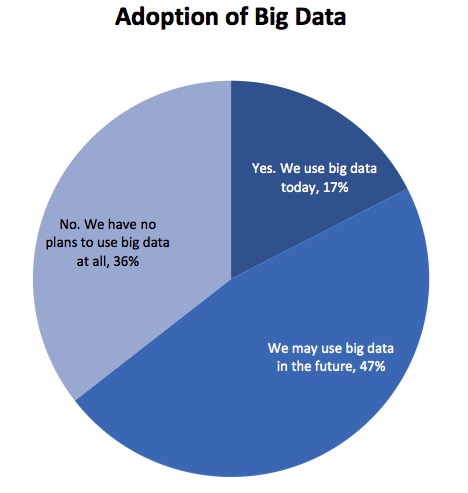 Companies are already actively using big data. They just don't call it that. While the phrase has problems, the technology is becoming more intrinsic to business.
Companies are already actively using big data. They just don't call it that. While the phrase has problems, the technology is becoming more intrinsic to business.
It turns out that no one knows what the heck big data is, and about the same number of companies are actually doing anything meaningful with it, according to a new study from Dresner Advisory Services. Surprised? More about the study? Click here.
You shouldn't be. After all, despite years of big data prognostication, most companies still struggle to even put little data to use.
This isn't to suggest that big data isn't a big deal, or that companies aren't deriving massive value today from their data. It is and they are. But, to get value from big data, companies first need to get real.
Who needs it?
As Datamation's James Maguire captures, Dresner Advisory Services doesn't see much adoption of big data.

Just 17% of companies acknowledge using big data today, with another 47% putting it off into an indeterminate future. No wonder, then, that the report's authors conclude, "Despite an extended period of awareness building and hype, actual deployment of big data analytics is not broadly applicable to most organizations at the present time."
Big data, big nothing?
Well, no. After all, 59% of the report's respondents also claim big data is "critically important," despite not doing anything with it (apparently). Something is clearly going on here....
That "something," I suspect, is just definitional.
You keep using that word...
Way back in the prehistoric world of 2012, NewVantage Partners upended the prevailing wisdom of what the "big" in big data actually meant. Despite tons of hype around petabyte-scale data problems, largely fueled by Hadoop and its ecosystem vendors, the reality was (and is) that most companies don't have petabyte-scale problems.
The primary problems most companies struggle with involve variety and velocity of data, as the survey uncovered.
The market is finally starting to grok this, investing increasing amounts of money in technologies that more easily manage diverse data types (e.g. NoSQL databases like MongoDB and DataStax-sponsored Cassandra), and handle streaming data (e.g. Apache Spark).
At the same time, enterprises continue to turn to more traditional data infrastructure like Oracle. As DB-Engines found in its 2015 year-end review, Oracle was the biggest gainer in terms of overall popularity last year (measured in terms of job postings, tech forum mentions, Google searches, etc.).
More than sexy-cool NoSQL. More than cloud-first Amazon. More than anything.
Of course, some of this increased Oracle usage has nothing to do with big data, and everything to do with managing neat-and-tidy rows-and-column data. But, based on NewVantage Partners' survey data, this comparatively "small" data is still where most of the big data analytics action resides.
Moving beyond this structured data, too, I suspect many companies still don't think of varied, high-velocity data as "big data." This may be one reason so few companies claim to be doing much of anything with big data. As MySQL database engineer Justin Swanhart put it, "Big data is meaningless. You might as well ask people what color database they want."
In short, big data is alive and well, but companies don't necessarily think of it as "big."
So what?
For enterprises wondering if they're being left behind by big data, it's time to stop worrying. As Gartner analyst Nick Heudecker posits, "big data" has migrated into more familiar categories:
- Advanced analytics and data science
- Business intelligence and analytics
- Enterprise information management
- In-memory computing technology
- Information infrastructure
Most enterprises are already engaged in projects that put big data to use. They just don't call it that. Even so, there's still a lot of work to do. As Michael Schrage, a research fellow at MIT Sloan School's Center for Digital Business, puts it:
"[The] most enduring impact of predictive analytics...comes less from quantitatively improving the quality of prediction than from dramatically changing how organizations think about problems and opportunities."
In other words, companies may already own the requisite technologies to put big data to work. What they lack is a desire to fundamentally change how they put that data to work. It's one thing to have a group of analysts decipher data, and quite another to use that data analysis to fuel real-time changes in one's business.
That's not the sort of thing you can buy from a vendor. It's something that has to change within the DNA of an enterprise. Between a more accurate understanding of big data, and actually doing something with it, enterprises have their work cut out for them.
Source: techRepublic